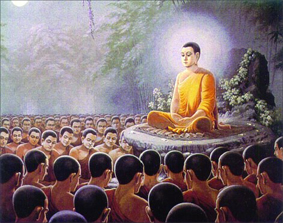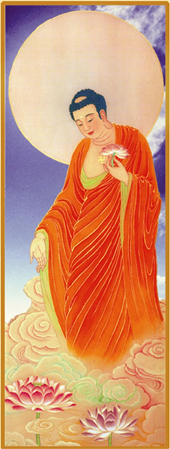|
The writer begins introducing himself
as an elderly Buddhist monk who joined the monastic order in 1990
at the age of sixty-nine years. Until then, he was a Professor of
Buddhist Studies at different universities both in Sri Lanka and
abroad, having started his academic career as a young lecturer in
Pali and Buddhism at the age of twenty-five.
The subject of Buddhist Studies about which a few
observations are made at this stage spreads over a very extensive
period of more than twenty-five centuries. Buddhism as a religious
system had its genesis in a specific cultural milieu in the Gangetic
valley of India in Asia. It was a young Sakyan prince named Siddhartha,
born into an agricultural family of royal lineage, who initiated
this new protestant movement within a Brahmin dominated Indian society
which until then upheld the creationist theory that Brahma created
the world and the people within it. The socially obnoxious divisive
caste theories of India which criminally fragmented the human community
came in its wake. The respect, even for human life, came to be graded
in terms of the social elitism of the divine origin of man out of
the primeval being in the Purusa Sukta.
 |
Discovering the way of salvation out of the sufferings
of human life, propounded by him latterly as dukkha and nirodha,
Siddhartha came to be called the Enlightened One or Buddha. It was
a personal triumph called Nirvana in the termination of the painful
process of Samsaric continuance which Siddhartha achieved as a human
in this very life. It was well and truly a liberation, a release
in this very existence, a jivan mukti, a Nirvana here and now, whether
one calls it Nirvana or Parinirvana. It is not one beyond death
or videha mukti as unmistakably declared to be in all forms of theo-centric
salvation systems.
The Buddha categorically declared that every human
had to obtain this goal of Nirvana the same way, each one by him-self.
For salvation in Nirvana, there was no external refuge which one
seeks or goes to [attano loko anabhissaro]. This position dominated
Buddhism during its early history, for nearly three to four hundred
years. However, towards the beginning of the Christian era, there
began to appear the idea that humans could seek the assistance of
a hierarchy of divine spiritual supporters or heavenly guardians
under the name of bodhisattvas. They are presented as providing
security to humans during worldly calamities like fires, burglaries
and other threats to life. Their emergence is clearly seen in works
like the Saddharmapundarika Sutra.
 |
These bodhisattvas work as divine emissaries for
and on behalf of the Buddha who by this time had also been elevated
to the position of a divine source of power, stretching through
time and space, for the sheer benefit of mankind. This is the Buddha
who now is omnipresent, the Buddha endlessly stretching through
time and space. This limitlessness of the Buddha is the key note
of the word AMIDA. He is limitless in space because he is, as AMITA
+ ABHAH, i.e. limitless radiance. He is equally limitless in time
because he is, as AMITA + AYUH, i.e. limitless life span. It seems,
as it were, unimaginable to accept that Shakyamuni or Buddha Gotama,
at the end of 80 years, had left the world for ever. He had to continue
to be in the world.
These trends, in handling material connected with
religion, we would look upon as deflections and deviations from
the original corpus of Buddhist thinking and teachings. They freely
elaborate and expand as imagination would allow. Here we would not
grudge the need for this. But we would firmly resist the use of
the term development for this trend. Or more specifically, the development
of Buddhism in any form.
In the context of academic studies in the world
today, of what to teach and how to teach, any serious undertaking
of Buddhist studies, whether at undergraduate or at postgraduate
levels, must in its totality not only scrutinize subtleties of diverse
areas of Buddhist thinking, but also include studies on the cultural
impact of Buddhism on the lives of people who adopt it. These would
include art and architecture, social institutions, family growth,
statecraft, agricultural and industrial development, trade and etc.
etc.
Yet another vital area has to be the comparative
study of the extant literature preserved in different languages
like those of Thailand, Myanmar, Sri Lanka on the one hand and those
of China, Japan and Korea on the other.
|



